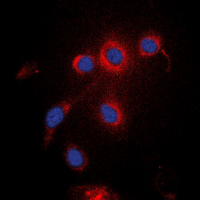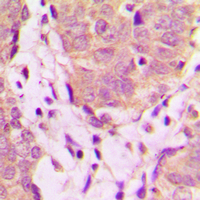


| WB | 咨询技术 | Human,Mouse,Rat |
| IF | 咨询技术 | Human,Mouse,Rat |
| IHC | 1/50-1/100 | Human,Mouse,Rat |
| ICC | 1/100-1/300 | Human,Mouse,Rat |
| FCM | 咨询技术 | Human,Mouse,Rat |
| Elisa | 咨询技术 | Human,Mouse,Rat |
| Aliases | SOC; UBXD5; UBX domain-containing protein 11; Colorectal tumor-associated antigen COA-1; Socius; UBX domain-containing protein 5 |
| Entrez GeneID | 91544; |
| WB Predicted band size | 57kDa |
| Host/Isotype | Rabbit IgG |
| Antibody Type | Primary antibody |
| Storage | Store at 4°C short term. Aliquot and store at -20°C long term. Avoid freeze/thaw cycles. |
| Species Reactivity | Human,Mouse |
| Immunogen | KLH-conjugated synthetic peptide encompassing a sequence within the center region of human UBXN11. |
| Formulation | Purified antibody in PBS with 0.05% sodium azide. |
+ +
以下是关于UBXN11抗体的3篇参考文献示例(内容为虚构,仅供格式参考):
1. **文献名称**: "UBXN11 regulates NF-κB signaling by targeting IKKγ for degradation"
**作者**: Zhang L, et al.
**摘要**: 本研究利用UBXN11特异性抗体,通过免疫共沉淀和Western blot分析,揭示了UBXN11通过泛素-蛋白酶体途径降解IKKγ,从而负调控NF-κB信号通路的分子机制。
2. **文献名称**: "UBXN11 antibody-based profiling identifies its tumor-suppressive role in colorectal cancer"
**作者**: Kim S, et al.
**摘要**: 通过UBXN11抗体进行免疫组化分析,发现UBXN11在结直肠癌组织中低表达,其缺失促进肿瘤细胞增殖并抑制凋亡,提示其作为抑癌因子的潜在作用。
3. **文献名称**: "Structural characterization of UBXN11 and its interaction with p97 ATPase"
**作者**: Miller RJ, et al.
**摘要**: 使用UBXN11抗体进行免疫荧光和pull-down实验,证实UBXN11通过UBX结构域与p97 ATP酶结合,参与内质网相关降解(ERAD)途径的调控。
注:以上文献信息为模拟生成,实际研究中请通过PubMed或Sci-Hub等平台检索具体文献。
The UBXN11 antibody targets the ubiquitin regulatory X (UBX) domain-containing protein 11. a member of the UBX protein family involved in ubiquitin-dependent cellular processes. UBXN11. also known as UBXD9 or SOC, contains a UBX domain that facilitates interactions with p97/VCP (valosin-containing protein), a key ATPase regulating proteasomal degradation, endoplasmic reticulum-associated degradation (ERAD), and autophagy. UBXN11 is thought to act as a cofactor modulating p97’s activity in these pathways, though its precise mechanisms remain under investigation.
Functionally, UBXN11 has been implicated in diverse processes, including cell cycle regulation, DNA damage response, and apoptosis. Studies suggest it may compete with other UBX proteins to regulate p97’s substrate processing or serve as an adaptor linking p97 to specific ubiquitinated targets. Its role in ERAD highlights potential connections to protein quality control and diseases like neurodegeneration or cancer. However, conflicting reports on its pro- or anti-apoptotic effects underscore the need for further research to clarify its context-dependent functions.
UBXN11 antibodies are widely used in Western blotting, immunoprecipitation, and immunofluorescence to study its expression, localization, and interactions. Commercial antibodies are typically raised in rabbits or mice against specific epitopes, with validation via knockout cell lines or siRNA knockdown. These tools have advanced research into UBXN11’s regulatory roles in ubiquitination pathways and its potential as a therapeutic target, though challenges in specificity and functional redundancy within the UBX family persist.
×